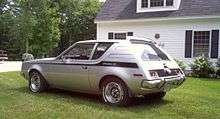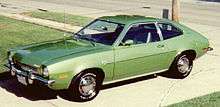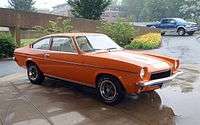Subcompact car
Subcompact car is an American classification for cars which is broadly equivalent to the B-segment (Europe) or supermini (Great Britain) classifications, and smaller than a compact car.

According to the U.S. Environmental Protection Agency (EPA) car size class definition, the subcompact category sits between minicompact and compact categories.[1] The EPA definition of a subcompact is a passenger car with a combined interior and cargo volume of between 85–99 cubic feet (2,410–2,800 L).[2] Current examples of subcompact cars are the Ford Fiesta and Chevrolet Sonic. The smaller cars in the A-segment / city car category (such as the Chevrolet Spark and Smart Fortwo) are sometimes called subcompacts in the U.S., because the EPA's name for this smaller category— minicompact— is not commonly used by the general public.[3]
The prevalence of small cars in the United States increased in the 1960s due to increased imports of cars from Europe and Japan. Widespread use of the term subcompact coincided with the early 1970s increase in subcompact cars built in the United States. Early 1970s subcompacts include the AMC Gremlin, Chevrolet Vega and Ford Pinto.
History
1960s
The term subcompact originated during the 1960s,[1][4] however it came into popular use in the early 1970s, as car manufacturers in the United States began to introduce smaller cars into their line-up.[5]
Previously, cars in this size were variously categorized, including "small cars" [6][7](p120) and "economy cars". Several of these small cars were produced in the U.S. in limited volumes, including the 1930 American Austin (later called the American Bantam)[8] and the 1939 Crosley. From the 1950s onwards, various imported small cars were sold in the U.S., including the Nash Metropolitan, Volkswagen Beetle and various small British cars.
1970s
Due to the increasing popularity of small cars imported from Europe and Japan during the late 1960s, the American manufacturers began releasing competing locally-built models in the early 1970s.[9] The AMC Gremlin was described at its April 1970 introduction as "the first American-built import" and the first U.S. built subcompact car.[10][11] Also introduced in 1970 were the Chevrolet Vega and Ford Pinto. Sales of American-built "low weight cars" (including subcompacts) accounted for more than 30% of total car sales in 1972 and 1973, despite inventory shortages for several models.[12] The Gremlin, Pinto and Vega were all rear-wheel drive and available with four-cylinder engines (the Pinto was also available with a six-cylinder engine, and the Gremlin was also available with six-cylinder and V8 engines).
The Pontiac Astre, the Canadian-born re-badged Vega variant was released in the U.S. September 1974. Due to falling sales of the larger pony cars (such as the Chevrolet Camaro and first generation Ford Mustang) in the mid-1970s, the Vega-based Chevrolet Monza was introduced as an upscale subcompact and the Ford Mustang II temporarily downsized from the pony car class to become a subcompact car for its second generation. The Monza with its GM variants Pontiac Sunbird, Buick Skyhawk, Oldsmobile Starfire, and the Mustang II continued until the end of the decade. The Chevrolet Chevette was GM's new entry-level subcompact introduced as a 1976 model. It was an 'Americanized' design from Opel, GM's German subsidiary. And then there were subcompacts that were imported but sold through a domestic manufacturers dealer network Captive imports, the Renault Le Car and the Ford Fiesta
In 1977, the U.S. Environmental Protection Agency (EPA) began to use a new vehicle classification system, based on interior volume instead of exterior size.[13](p3) This resulted in cars previously classified as subcompact (such as the AMC Gremlin, Ford Pinto and Chevrolet Vega) now being classified as compact cars, and a smaller group of cars now being classified as subcompact.
In 1978, Volkswagen began producing the "Rabbit" version of the Golf— a modern, front-wheel drive design— in Pennsylvania. In 1982, American Motors began manufacturing the U.S. Renault Alliance— a version of the Renault 9— in Wisconsin. Both models benefiting from European designs, development, and experience.[14]
1980s
To replace the aging Chevette in the second half of the 1980s, Chevrolet introduced marketed imported front-wheel drive subcompact cars: the Suzuki Cultus (a three-cylinder hatchback, badged as the Chevrolet Sprint) and the Isuzu Gemini (a four-cylinder hatchback/sedan badged as the Chevrolet Spectrum).
2000s to present
Because of consumer demand for fuel-efficient cars during the late-2000s, sales of subcompact cars made it the fastest growing market category in the U.S.[15]
As of 2016, numerous models of subcompacts are sold in North America. As of 2012, the Chevrolet Sonic was the only subcompact fully assembled in the United States.[16] Imported subcompact cars include Korean models such as the Hyundai Accent and Kia Rio along with Japanese models such as the Honda Fit, Mazda 2 (discontinued after 2014), Nissan Micra, Scion xD (discontinued 2016), Suzuki Swift (produced and sold only in Mexico), Toyota Yaris and Toyota Prius C (discontinued after 2017) European made models are limited but include Mini Cooper, Fiat 500 (to be discontinued in 2020) and Smart Fortwo (discontinued after 2019)
Ford reintroduced the Ford Fiesta in the North American market in 2010 but discontinued it in 2019. The cars were produced in Mexico.
See also
- Car classification
- Mini SUV
- Economy car
References
- "subcompact". merriam-webster.com. Retrieved 16 July 2017.
- "FAQ - How are vehicle size classes defined?". www.fueleconomy.gov. Retrieved 5 January 2012.
- Patton, Phil (9 September 2012). "Taking the 'Cheap' Out of the Small Car". The New York Times. Retrieved 10 September 2012.
- "The definition of subcompact". www.dictionary.com. Retrieved 31 December 2018.
- Shuldiner, Herbert (March 1972). "PS Tests Five Camping Trailers Can you match these little campers safely to your car?". Popular Science. 200 (3): 96.
The boom in subcompact cars is on.
- Foster, Patrick (2005-10-01). "Developing the Metropolitan". Hemmings Classic Car. Retrieved 2012-01-05.
During WWII and immediately afterwards, Mason began to explore the idea of developing a truly small car, the size of what today we'd call a subcompact.
- Popular Mechanics (November 1954 ed.). Hearst Magazines. 1954. Retrieved 31 December 2018.
- U.S. Senate 93rd Congress (April 1974). "Second Session on S. 1167, Part 4: Ground Transportation Industries". Hearings Before the Subcommittee on Antitrustand Monopoly of the Committee on the Judiciary: 2480. Retrieved 19 January 2019.
- Norbye, Jan P.; Dunne, Jim (November 1970). "The Small Car Detroit Doesn't Make: 4 doors, 4 seats, 4 cylinders". Popular Science. 197 (5): 36.
Detroit's small cars, sized and priced to compete head-on with the most successful sub-compact imports.
- Wilson, Bob. "1971 AMC Gremlin advertisement". arcticboy. Retrieved 2012-01-05.
- Auto Editors of Consumer Guide (2007-10-17). "1970-1978 AMC Gremlin". HowStuffWorks.com. Retrieved 2012-01-05.
- Survey of Current Business. 54. U.S. Department of Commerce. May 1974. p. 6. Retrieved 16 July 2017.
- 1977 Gas Mileage Guide (950R77039). Washington DC: U.S. Environmental Protection Agency. September 1976. Retrieved 31 December 2018.
- Norbye, Jan P. (January 1982). "Renault 9 - American Motors subcompact for 83". Popular Science. 220 (1): 22. Retrieved 16 July 2017.
- Mitchell, Jacqueline (2008-08-29). "Most Fuel-Efficient American Cars". Forbes. Retrieved 2012-01-05.
- "Made in USA: 4 new cars roll out of U.S. factories". www.cbsnews.com. Retrieved 2 January 2019.


